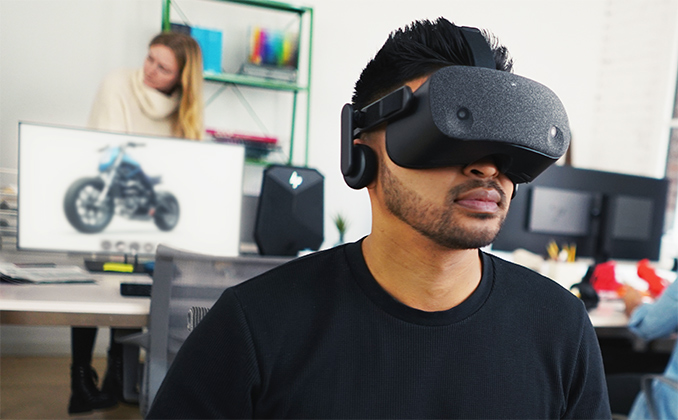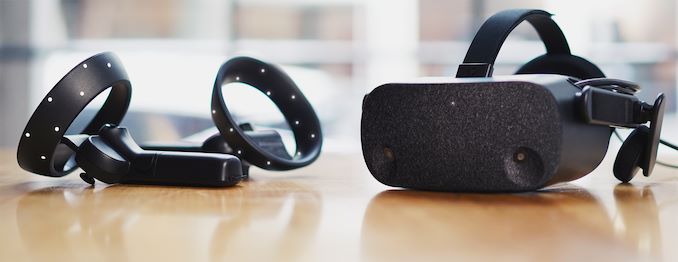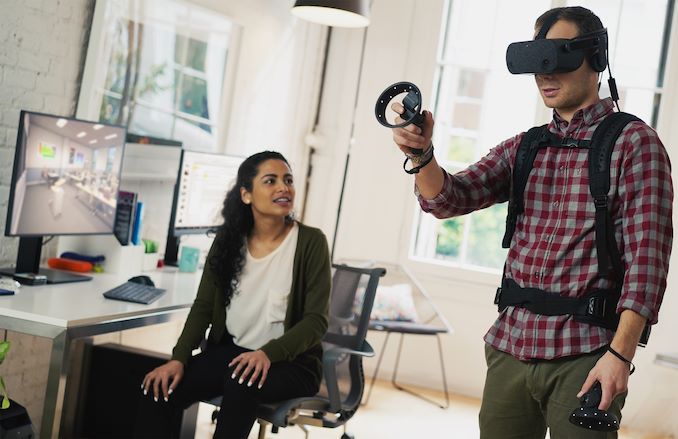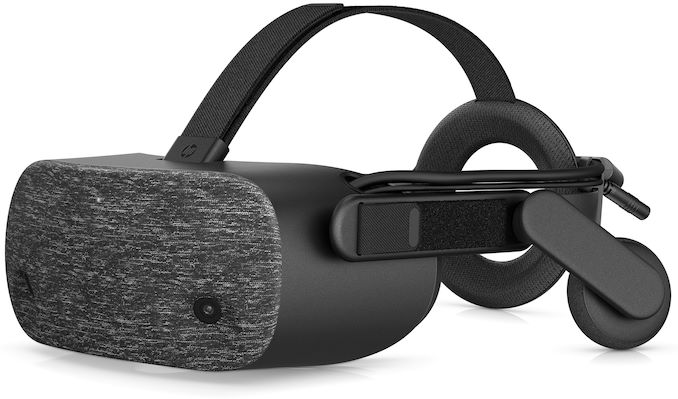HP Reverb Virtual Reality Headset: A 4K HMD with 6DOF
by Anton Shilov on March 20, 2019 5:00 PM EST
Numerous companies are making attempts to drive VR technology to the commercial space. HP this week introduced its first AR/VR headset that was designed from the ground both for consumer as well as for commercial/professional applications.
The HP Reverb VR headset is outfitted with two 2.89-inch screens featuring a 2160×2160 resolution per eye (4320×2160 combined resolution), a 90 Hz refresh rate, and a 114-degree field of view. The head mounted display (HMD) comes with a built-in inside-out 6-degree-of-freedom (6DoF) positional tracking and therefore does not need any external sensors. It also has its own spatial audio headset, and two front-facing cameras to enable augmented reality applications. The device also comes with Bluetooth connected motion controllers that are pre-synced to the headset to simplify setup.
To make the Reverb VR HMD more comfortable to use, HP outfitted it with a rather unique adjustable headstrap featuring a built-in cable management and enhanced ergonomics to compensate the weight and ensure that the headset does not fall.
HP’s Reverb headset requires a rather powerful PC with a DisplayPort 1.3 connection to ensure proper performance at a 4320×2160 resolution with a 90 Hz refresh rate. HP says that the head-mounted display is fully compatible with its Z VR wearable backpack PC, but keep in mind that certain programs might need a high-end graphics card only found in gaming/workstation desktops.
The HP Reverb VR headsets — both the Professional and Consumer Editions — can work perfectly with Windows Mixed Reality, and SteamVR applications (which are mostly games). The only hardware difference between the two versions is their bundle: the Pro model comes bundled with a 0.6-meter cable for HP's Z VR Backpack PC as well as a cleanable face cushion.
HP will start selling its Reverb VR headsets in late April. The consumer version will cost $599, the price of the professional model will be disclosed at a later date. Both HMDs will be covered with a one-year warranty with optional care packs for the Pro flavor.
Related Reading:
- Japan Display Develops VRM-100 VR Headset with 3DOF for Business Users
- HP Windows Mixed Reality Headset, Professional Edition, Coming March
- VR Startup Varjo Announces Shipping of High Resolution Headset Prototype, Aimed at Professional Markets
- Windows Mixed Reality Headsets Gain SteamVR Support, a Library of VR Games
- HP Expands Commercial VR Strategy: Z VR Backpack and Immersion Centers
Source: HP















42 Comments
View All Comments
wrkingclass_hero - Wednesday, March 20, 2019 - link
LCD or AMOLED?Alexvrb - Wednesday, March 20, 2019 - link
LCD but if you read up on it, it's actually an advantage for them in this case. See my comment above.eastcoast_pete - Thursday, March 21, 2019 - link
As least by specs, definitely a step forward. Question @Anton: Is this compatible with eye glasses, or can (affordable!) lenses be had, and if yes, up to what strength? Several existing VR headsets are either incompatible (= useless) or very uncomfortable if you need to wear "corrective lenses" (from my driver's license). In many parts of the world, that applies to almost half the potential customer base.mebalzer - Thursday, March 21, 2019 - link
I do not have a problem with price. Every VR system I purchased has started out at or above $600, including the original HP WMR. I personally think this is a home run for HP who also creates a VR backpack for the enterprise/professional market. As far as continuing to use the MS inside/out tracking, I personally have not had any issues with it and use it for a few games. In fact as we are seeing with both WMR and the Oculus Quest, large spaces are quite possible if you are willing to add high contrast random lines to your walls & floor. Something I discovered as soon as attached one to my VR-NUC belt system and walk around outside realizing grass, shrubs and bushes did a great job of creating patterns, whereas a parking lot with its black asphalt either lost tracking immediately or soon after. It is still my goal to open up a VR center in a large space for Architects, Engineers, Urban planners and designers to review with their clients in a 1:1 scale space.Of course wearing a PC on your back is less than ideal, and due to the requirement of sending the camera feeds back to the PC has hampered wireless solution like those for the HTC Vive & Vive Pro. It would be interesting if the Oculus inside/out tracking does its positional tracking within the headset and providing only sparse point cloud and even positional tracking data only, reducing the bandwidth needed to be handled by the USB port. This may account for its $400 price tag even though it uses LCD panel (s?) like that used in the Oculus Go that sells for $200.
Also, as others have posted, LCD is not that bad and other than not being able to reach same levels of black, they seem to have less mura and pixel noise. Plus, I can't say either the Vive or the Rift have very deep blacks. As a developer you create content that minimizes dark scenes anyway.
Dug - Thursday, March 21, 2019 - link
Sense a lot of games even with high end video cards won't be able to output that resolution @ 90hz, what will be the best compromise? Can you lower resolution of game and let display upscale? Or do you try to keep native resolution and reduce all the fancy graphics?Valantar - Friday, March 22, 2019 - link
Both are viable options, both with unique drawbacks and advantages. Most VR games seem to go for more stylized art styles and less photorealism, as this scales better across various levels of detail, allowing you to maintain resolution. Jaggies in VR are extremely highly visible (as the actual amount of pixels in your main field of vision is low), so AA and good upscaling is a requirement for lowering resolution - but it can be done well.Of course, foveated rendering with eye tracking would all but solve this, as you'd only need full resolution rendering in a ~60x60-degree circular field, and could even reduce detail within the outer 30 degrees of this along each axis in a few metrics (sharpness of fine details, text, etc.). This way you'd be able to increase graphical fidelity dramaticaly while maintaining frame rates.
darkswordsman17 - Friday, March 22, 2019 - link
What happened to making USB-C (with DisplayPort) as the standard VR headset connector (enabling an easy single cable solution)?Alexvrb - Friday, March 22, 2019 - link
Ah yes, the single cable. Well there's the lack of VR-capable devices that have USB-C ports that meet all the requirements. Not just any ol' USB-C port will work. You need one that supports a sufficient tier of DP/HDMI (and a way to shunt the stream from your GPU) capable of driving the twin LCDs, and probably PD. USB-C is kind of a complete fustercluck. You can have a "USB-C" port that doesn't really support jack squat and it's still USB-C. Nothing appears to be mandatory except USB data of some speed and a tiny bit of power. So every port is a mystery. As mentioned if you don't have PD your headset probably still needs a separate power cable (or more USB cables). I mean even without PD there are ports that can deliver a lot of power at 5V, but they usually aren't found on PCs, and can the headset manufacturer guarantee that? So they might demand a PD profile of 2 or 3. Speaking of PD, voltage can go up to 20V @ 5A depending on profile! Confused? Good.The whole one cable to rule them all plan has kind of backfired. They've standardized everything but nothing comes standard! Separate cables combining into one cable works just fine.
simulanis - Thursday, March 28, 2019 - link
Virtual Reality is the best technology for educationkompanions - Friday, May 1, 2020 - link
Waiting for virtual reality took charge of future education. There is no doubt that VR is improving the learning experience. From augmented reality learning apps to virtual reality labs, both are future of schools and colleges classroom.Source: https://www.kompanions.com/k-lab.html